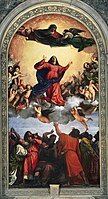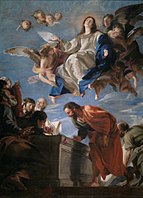Assumption of the Virgin Mary in art

The
Literary accounts with more detail, such as the presence of the Apostles, appeared in late medieval works such as the Golden Legend, and were followed by artists.[3] By the end of the Middle Ages, large and crowded altarpieces gave the artist the opportunity to show his virtuosity in composition, colouring and figure poses. After the Reformation, it was used to assert the Catholic position, rejected by Protestants.[4]

Normally accompanied or carried by angels (but not usually carried by Christ, as in Orthodox icons) the Virgin Mary rises passively heavenward, where she is to be crowned by Christ, while the Apostles below surround her empty tomb as they stare up in awe.
Iconographic details
Some versions show the Virgin dropping her belt, the Girdle of Thomas, to Thomas the Apostle (best known for his Doubting Thomas episode) as she rises; this was to give him tangible proof of what he had seen, given his earlier scepticism.[8] The "girdle" was a major relic of the Middles Ages, naturally existing in several versions. In a miniature by the Master of James IV of Scotland (1510s), an angel passes it down to Thomas. This also has the unusual scene of the funeral procession with the Apostles.[9]
Rubens introduced two women, perhaps meant to be Martha and Mary, kneeling by the sarcophagus or bending over it. Having apparently unwrapped the shroud, they are usually holding it and collecting the roses found within. This motif was often included by later Flemish artists.[10]
Although the final age of Mary is not given in the
The alternative Catholic scene from the end of the Virgin Mary's early life is the
Though once common in Catholic art, the last major treatment of the Death of the Virgin by itself was Caravaggio's painting in the Louvre, who caused a stir by depicting her as an untidy and realistic corpse, which some considered a breach of decorum, though compatible with the doctrine of the Church.[15]

The Assumption was a suitable subject for
Selected works
With articles
- Assumption of the Virgin (Andrea del Castagno), 1449–50
- Assumption of the Virgin by Francesco Botticini 1475–76
- Assumption of the Virgin (Perugino) 1506
- Heller Altarpiece, 1507–09, Albrecht Dürer
- Perugino, 1513
- Assumption of the Virgin (Palma Vecchio), c. 1513
- Assumption of the Virgin (Rosso Fiorentino), 1513–14
- Assumption of the Virgin by Titian, 1515–1518
- Assumption of the Virgin (Fra Bartolomeo)c. 1516
- Panciatichi Assumption, Andrea del Sarto, c. 1522–23
- Assumption of the Virgin (Moretto), Moretto da Brescia, 1524–25
- Assumption Altarpiece by Moretto da Brescia, 1529–30.
- Assumption of the Virgin by Antonio da Correggio, 1526–1530
- Assumption of the Virgin, by El Greco, c. 1577–79
- Assumption of the Virgin by Annibale Carracci, 1590
- Cerasi Assumption by Annibale Carracci, 1600–01
- Assumption of the Virgin (Gentileschi)(Orazio), 1605–1608
- Assumption (Guercino), c.1623
- Cathedral of Our Lady, Antwerp
- Liechtenstein Collection
Other
- The Assumption of the Virgin by Bernardo Daddi, c. 1337–1339[17]
- The Assumption of the Virgin with St. Thomas and Two Donors (Ser Palamedes and his Son Matthew) by Andrea di Bartolo, c. 1390s[18]
- The Dormition and the Assumption of the Virgin by Fra Angelico, 1424–1434[19]
- Assumption of the Virgin by Michaelangelo di Pietro Membrini, c. 1498[20]
- The Assumption of the Virgin, with the Nativity, the Resurrection, the Adoration of the Magi, the Ascension of Christ, Saint Mark and an Angel, and Saint Luke and an Ox by Joachim Patinir, c. 1510–1518[21]
- Assumption of the Virgin (L'Assomption) by Jacques Callot, c. 1592–1635[22]
- Assumption of the Virgin by Giovanni Lanfranco, before 1647[23]
- Assumption of the Virgin by Guercino, 1650[24]
- The Assumption of the Virgin by Giambattista Piazetta, 1735[25]
- Virgin of the Apocalypse by Gaetano Gandolfi, 1770–1780[26]
- The Assumption of the Virgin, by Martin Johann Schmidt, called Kremser-Schmidt, 1773[27]
Gallery
-
Maso di Banco, 1337–1339, Berlin. The girdle of Thomas hangs down from the Virgin's hand.
-
Thomas catches the belt. Detail, by Matteo di Giovanni, c. 1474.[28]
-
Choir stall in Amiens Cathedral, 1508–1519
-
Miniature by the Netherlandish Master of James IV of Scotland, 1510s
-
Andrea del Sarto, 1526
-
Annibale Carracci, 1600–01
-
Annibale Carracci Assumption, 16th century
-
RubensAssumption of the Virgin, 17th century
-
Juan Martín Cabezalero Assumption of the Virgin, c. 1665
-
Wilhelm Hauschild, Lochen Church, 19th century
Notes
- ^ Baumstark, 356; Hall (1996), 34
- ^ Hall (1983), 180–181; Baumstark, 356
- ^ Hall (1996), 34; see Caxton
- ^ Hall (1983), 338–340; Baumstark, 356; Zirpolo, 83
- ^ Hall (1996), 34–35; Baumstark, 360
- ^ Baumstark, 356
- ^ Zirpolo, 83
- ^ Hall (1996), 35, 301
- ^ Getty Museum; Hall (1996), 95
- ^ Baumstark, 359; Hall (1996), 35
- ^ a b Caxton
- ^ Baumstark, 360
- ^ Hall (1983), 327–328
- ^ Hall (1996), 94–95; Caxton
- ^ Zirpolo, 213–214
- ^ Hall (1983), 330–332
- ^ "The Assumption of the Virgin". Archived from the original on 2016-03-05.
- ^ "The Assumption of the Virgin with St. Thomas and Two Donors (Ser Palamedes and his Son Matthew) (Primary Title) – (54.11.3)". Virginia Museum of Fine Arts |. Retrieved 2021-01-06.
- ^ "The Dormition and Assumption of the Virgin | Isabella Stewart Gardner Museum". www.gardnermuseum.org. Retrieved 2021-01-06.
- ^ "Assumption of the Virgin". emuseum.ringling.org. Retrieved 2021-01-06.
- ^ "Philadelphia Museum of Art – Collections Object : The Assumption of the Virgin, with the Nativity, the Resurrection, the Adoration of the Magi, the Ascension of Christ, Saint Mark and an Angel, and Saint Luke and an Ox". www.philamuseum.org. Retrieved 2021-01-06.
- ^ "Exchange: Assumption of the Virgin [L'Assomption]". exchange.umma.umich.edu. Retrieved 2021-01-06.
- ^ "Exchange: Assumption of the Virgin". exchange.umma.umich.edu. Retrieved 2021-01-06.
- ^ "Assumption of the Virgin". www.dia.org. Retrieved 2021-01-06.
- ^ "The Assumption of the Virgin". Archived from the original on 2015-08-03.
- ^ "Exchange: Virgin of the Apocalypse". exchange.umma.umich.edu. Retrieved 2021-01-06.
- ^ "Blanton Museum of Art – The Assumption of the Virgin". collection.blantonmuseum.org. Retrieved 2021-01-06.
- ^ Full picture, National Gallery
References
- Baumstark, Reinhold, Liechtenstein: The Princely Collections, 1985, Editors: Bradford D. Kelleher, John P. O'Neill, Metropolitan Museum of Art and Sammlungen des Regierenden Fürsten von Liechtenstein, ISBN 978-0870993855, Google books
- Caxton, William, English edition of the Golden Legend, in English translation, probably by an unknown cleric, Story of the Assumption
- Hall, James (1996), Hall's Dictionary of Subjects and Symbols in Art, 1996 (2nd edn.), John Murray, ISBN 0719541476
- Hall, James (1983), A History of Ideas and Images in Italian Art, 1983, John Murray, London, ISBN 0719539714
- Zirpolo, Lilian H. (2018). Historical Dictionary of Baroque Art and Architecture. Rowman & Littlefield. ISBN 978-1538111291.


![Thomas catches the belt. Detail, by Matteo di Giovanni, c. 1474.[28]](http://upload.wikimedia.org/wikipedia/commons/thumb/f/fe/Matteo_di_giovanni%2C_assunzione_della_vergine%2C_1474_ca._02_san_tommaso_cintura.jpg/133px-Matteo_di_giovanni%2C_assunzione_della_vergine%2C_1474_ca._02_san_tommaso_cintura.jpg)











